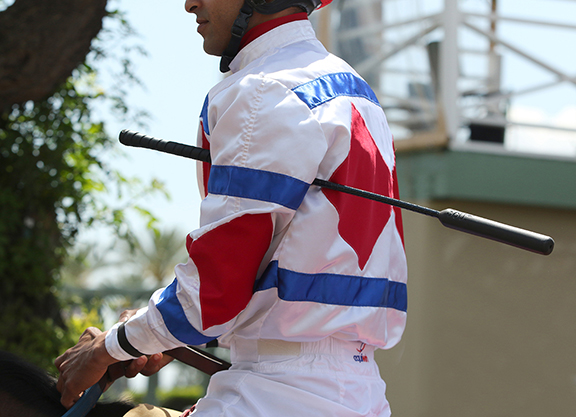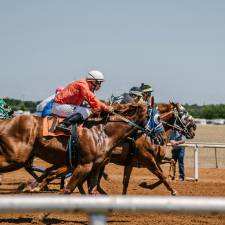
Ramón Dominguez and Ryan Moore
We have watched, with increasing concern, as momentum to effectively ban the use of the riding crop has built around the world. The negative perception of the crop is real and it matters. You may think it is overblown, the domain of activists, but those among us who dismiss animal welfare concerns will first find ourselves riding without crops, and then not riding at all.
We shoulder some blame in this scenario. As riders we have failed–and fail still–to make a persuasive argument about the crop’s use as a safety or corrective tool and its importance to the integrity of the sport.
We did not move quickly to innovate its design as criticism of it grew louder. For years, we have simply insisted “we need it” while refusing to compromise on a sustainable framework for its use.
And now, here we are. Faced with restrictive rules pending in California and regulatory bodies around the U.S. and the world debating the same issue. The time has passed for stubbornness, but we do need the riding crop to ensure the safety and integrity of our sport for all participants.
Corrective Action
There are so many ways in which a horse can act unpredictably during the running of a race and require a rider to take corrective action to protect themselves as well as the animal. A crop is the most important tool a rider can rely on to correct a horse.
These corrections are not always clear cut and often a matter of feel for the jockey given position in the race, communication with the horse, and overall experience.
Being able to proactively use the crop, for example by tapping a horse on the shoulder anticipating that he/she is going to do something erratic, is much safer than trying to correct a horse who has already drifted. In a scenario where the crop can only be used for “safety,” a rider will have to wait for the unsafe situation to become apparent or face penalties. This increases risk for all participants.
In addition to maintaining safety, the crop is necessary to maintain a level playing field. An unpredictable race creates uncertainty that is unattractive to the gamblers who are critical to racing’s funding. Horses have different demeanors. Some are quick and come out of the gate running as fast as they can.
As a rider, your goal is to help ration that speed so that they can conserve energy for the end of the race. Some horses have a laid-back demeanor and will only put forth effort according to what’s asked of them. These horses will not give their best if the crop cannot be used for encouragement.
This does a disservice to the animal’s connections and to the betting public. A horse’s inherent demeanor is invisible to the bettor and impossible to handicap. In order to offer a fair race, jockeys need to be able to use crops to encourage their mounts.
While crops are essential, we’re not advocating their unrestricted use. It is time for jockeys to come to the table prepared to discuss common sense rules. We will not be able to use the crop as we always have–change is not coming, it is here.
Regulators must also be prepared to compromise–namely on an enforcement and penalty system that is intended to help jockeys learn to change their behavior, not to punish them. This will require a level of regular dialogue between riders and stewards that goes well beyond the current systems.
Innovations in Crop Design
Innovations in crop design also cannot be ignored in this debate. For most of the last century, this piece of equipment changed little. The rise of the padded popper, first in the UK and then the U.S., was a step toward minimizing impact on the horse, but it has always had flaws.
First, the synthetic material on the outside of the popper can deteriorate over time and retain water, making it heavier, which contributes to increased impact on the animal.
Second, the popper has hard edges where the outer material is stitched together over the padding. If a rider hits at the wrong angle–an easy thing to do during a race without realizing it–this hard edge can and will break a horse’s skin.
The new 360 GT crop designed by Ramón Dominguez elevates the protection of the horse to another level–replacing the hard, sharp edges of the traditional padded popper with a smooth, waterproof foam cylinder that is far gentler on the horse and just as effective as an encouragement tool due in part to the loud sound it makes on contact.
Its widespread adoption, along with education about its benefits, could transform the conversation about crop use globally.
The crop has evolved. It is time for us to evolve in the way we use it.
Ramón Dominguez is a retired Hall of Fame Rider based in the United States and the founder of Ryders Up, manufacturer of the 360 GT. Ryan Moore is a three-time British champion jockey who competes globally.
This article originally appeared on Thoroughbred Daily News and is published here with permission.
Find more interesting articles in our section on Horse Racing.
Are you interested in promoting your business or sharing content on EIE? Contact us at info@equineinfoexchange.com













